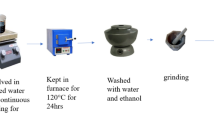Abstract
We report here the potential competency of MnCO3 versus MnO2 for supercapacitor applications. MnCO3 was synthesized by a hydrothermal method using KMnO4 as a manganese source and either sugar or pyrrole as carbon source. MnCO3 synthesized using sugar and pyrrole as carbon source is referred hereafter as MnCO3(s) and MnCO3(p), respectively. The synthesized products were characterized by powder X-ray diffraction, scanning electron microscopic and transmission electron microscopic studies. Microscopic studies revealed that MnO2 possesses micro-flower-like morphology constructed by self-assembled nano-petals. While the morphology of MnCO3(s) is sub-micron size particles of different shape, the morphology of MnCO3(p) is crystalline particles of 10–20 nm dia. The capacitive characteristics of MnO2, MnCO3(s) and MnCO3(p) were evaluated in aqueous 0.1 M Mg(ClO4)2 electrolyte between 0 and 1 V using cyclic voltammetry and galvanostatic charge/discharge cycling. Specific capacitance (SC) values of 216 and 296 F g−1 obtained for MnCO3(s) and MnCO3(p) are 35 and 85 % higher than SC value of 160 F g−1 obtained for MnO2, respectively. Besides better capacitive storage characteristics, MnCO3(s) and MnCO3(p) have also exhibited better rate capability and cycle life than MnO2.








Similar content being viewed by others
References
Winter M, Brodd R J (2004) What are batteries, fuel cells, and supercapacitors. Chem Rev 104:4245–4269
Lang X, Hirata A, Fujita T, M. Chen (2011) Nanoporous metal/oxide hybrid electrodes for electrochemical supercapacitors. Nat Nanotechnol 6:232–236
Bockris JO’M (1972) The electrochemistry of cleaner environment. Plenum press, New York
Vincent CA, Scrosati B (1997) Modern batteries: an introduction to electrochemical power source. Arnold, London
Salkind AJ, Kelly JJ, Cennone AG (1995) Hand book of batteries. McGraw Hill, New York
Conway BE (1999) Electrochemical supercapacitors, scientific fundamentals and technological applications. Kluwer Academic/Plenum Press, New York
Conway BE (1991) Transition from “supercapacitor” to “battery” behavior in electrochemical energy storage. J Electrochem Soc 138:1539–1548
Jiang H, Lee PS, Li C (2013) 3D carbon based nanostructures for advanced supercapacitors. Energy Environ Sci 6:41–53
Sarangapani S, Tilak BV, Chen CPJ (1996) Materials for electrochemical capacitors theoretical and experimental constraints. J Electrochem Soc 143:3791–3799
Burke A (2001) Ultracapacitors: why, how, and where is the technology. J Power Sources 91:37–50
Largeot C, Portet C, Chmiola J, Taberna P-L, Gogotsi Y, Simon P, (2008) Relation between the ion size and pore size for an electric double-layer capacitor. J Am Chem Soc 130:2730–2731
Zhang K, Zhang LL, Zhao XS, Wu J (2010) Graphene/polyaniline nanofiber composites as supercapacitor electrodes. Chem Mater 22:1392–1401
Yu Z, Thomas J (2014) Energy storing electrical cables: integrating energy storage and electrical conduction. Adv Mater 26:4279–4285
Zhou C, Zhang Y, Li Y, Liu J (2013) Construction of high-capacitance 3D CoO@Polypyrrole nanowire array electrode for aqueous asymmetric supercapacitor. Nano Lett 13:2078–2085
Zheng JP, Jow TR (1995) A new charge storage mechanism for electrochemical capacitors. J Electrochem Soc 142:L6–L8
Zheng JP, Cygan PJ, Jow TR (1995) Hydrous ruthenium oxide as an electrode material for electrochemical capacitors. J Electrochem Soc 142:2699–2703
Lee HY, Goodenough JB (1999) Supercapacitor behavior with KCl electrolyte. J Solid State Chem 144:220–223
Hu CC, Tsou TW (2002) Ideal capacitive behavior of hydrous manganese oxide prepared by anodic deposition. Electrochem Commun 4:105–109
Toupin M, Brousse T, Belanger D (2002) Influence of microstucture on the charge storage properties of chemically synthesized manganese dioxide. Chem Mater 14:3946–3952
Hu CC, Wang CC (2003) Nanostructures and capacitive characteristics of hydrous manganese oxide prepared by electrochemical deposition. J Electrochem Soc 150:A1079–A1084
Devaraj S, Munichandraiah N (2008) Effect of crystallographic structure of MnO2 on its electrochemical capacitance properties. J Phys Chem C 112:4406–4417
Devaraj S, Gabriel GS, Gajjela SR, Balaya P (2012) Mesoporous MnO2 and its capacitive behavior. Electrochem Solid-State Lett 15:A57–A59
Lee HY, Kim SW, Lee HY (2001) Expansion of active site area and improvement of kinetic reversibility in electrochemical pseudocapacitor electrode. Electrochem Solid-State Lett 4:A19–A22
Devaraj S, Liu HY, Balaya P (2014) MnCO3: a novel electrode material for supercapacitors. J Mater Chem A 2:4276–4281
Huang Y, Huang Y, Meng W, Zhu M, Xue H, Lee CS, Zhi C, (2015) Enhanced tolerance to stretch-induced performance degradation of stretchable MnO2-based supercapacitors. ACS Appl. Mater. Interfaces, 7:2569–2574
Park BO, Lokhande CD, Park HS, Jung KD, Joo OS (2004) Performance of supercapacitor with electrodeposited ruthenium oxide film electrodes—effect of film thickness. J Power Sources 134: 148–152
Devaraj S, Munichandraiah N (2007) Electrochemical supercapacitor studies of nanostructured α-MnO2 Synthesized by microemulsion method and the effect of annealing. J Electrochem Soc 154:A80–A88
Acknowledgements
SD acknowledges financial support (SB/FT/CS-025/2014) and international travel support (ITS/1484/2015-2016) by Science and Engineering Research Board, Department of Science and Technology, India. SD and PV thank SASTRA University for infrastructure and instrument facilities.
Author information
Authors and Affiliations
Corresponding authors
Rights and permissions
About this article
Cite this article
Devaraj, S., Vardhan, P.V., Liu, H.Y. et al. Metal carbonates: alternative to metal oxides for supercapacitor applications? A case study of MnCO3 vs MnO2 . J Solid State Electrochem 20, 1877–1883 (2016). https://doi.org/10.1007/s10008-015-2972-y
Received:
Accepted:
Published:
Issue Date:
DOI: https://doi.org/10.1007/s10008-015-2972-y




